BNCO Mobil Directo: Difference between revisions
No edit summary |
No edit summary |
||
| (26 intermediate revisions by 5 users not shown) | |||
| Line 1: | Line 1: | ||
{{Infobox siren | {{Infobox siren|image=Memphis_Directo.png|company=Biersach & Niedermeyer (BNCO)|produced=1942-1967|output=126-130 dB @ 100 ft|type=[[Rotational]] [[Electromechanical]] | ||
|image= | [[Rotational]] [[Engine-Driven]]|hz=50/60|hp=10-25 hp|voltage=240/550|current=AC 3 ph|succeeded=[[ACA Allertor 125]]|caption=A refurbished BNCO Mobil-Directo Model BN44E, which was located in Memphis, TN. It was replaced by a [[Sentry 10V2T]] due to rotator damage caused during installation.}}The '''Mobil-Directo''' was a rotational civil defense siren, made by [[Biersach & Niedermeyer Co.|Biersach & Niedermeyer]] (BNCO) from 1942 until 1967, and was the predecessor of ACA's [[ACA Allertor 125|Allertor 125]]. It was one of the earliest rotational sirens ever created and boasted unparalleled sound output when it was released. It found extensive use throughout the United States and Canada during the Cold War. | ||
|produced= 1942-1967 | |||
| | |||
|type= [[Electromechanical]] | |||
|succeeded= [[Allertor 125]] | |||
| | |||
}} | |||
= | =History= | ||
The Mobil Directo was a | [[File:Mobil20directo20ad20195220sm.jpg|left|thumb|220x220px|An ad for the Mobil-Directo.]] | ||
The Mobil-Directo was created in the early 1940s by Biersach & Niedermeyer (BNCO), a steel company that had been in business since 1873, founded by Louis Biersach and August Niedermeyer. The company was contracted by the American government to create a high-powered air raid siren that would be suitable for use in both the domestic market as well as in the Pacific Theatre. The original gas-powered Mobil-Directo would be designed by Sydney J. Lattow—a former salesman for Federal Electric)—and began production in 1942 using the revolutionary principle of a directional, rotational siren. Later in 1948, after the success of the gas-powered variant, an electric variant would begin production. A dual tone chopper would also be introduced. Late in the siren's production, an omnidirectional variant would be sold as the [[BNCO Model 110|Model 110]], though only one is known to have been sold which still survives to this day. | |||
BNCO's siren division became increasingly unprofitable throughout the 1960s as sales waned, and it was thus sold off in 1967, bringing the production of Mobil-Directo sirens to an end after a 25-year production run. BNCO's siren division was bought by James E. Biersach who reformed it into [[Alerting Communicators of America]], partially reusing the design (rotor, stator and projector) for the ACA Allertor 125. Today, Mobil-Directo sirens (the gasoline-powered ones, especially) are very rare, as most have been removed since the end of the Cold War, and/or replaced with newer sirens. Only three electric units still remain in service, 1 converted Model BN52 and 2 Model BN44E units, but the vast majority of remaining units sit silently, rusting away on their poles, a forgotten reminder of the perils of the Cold War. A privately owned BN52 originally from Milwaukee's original system underwent restoration by Jerry Wick and is currently the only operational gasoline-driven unit in existence. | |||
= | =Design= | ||
The Mobil-Directo uses a unique split intake/projector design that was later carried over to the Allertor. The bottom horn is the intake, where air is drawn in through the chopper located inside the compression drum, and the sound comes out of the large top horn. The drum serves to compress and pressurize the sound and air, which is then forced out of the top projector horn through an L-bend. The siren's external dual-shafted motor (or engine) drives both the chopper as well as the rotator. The rotator is belt-driven from the motor/engine, using a pair of belts connected to a worm-gear reduction drive that drives a single powered wheel and two unpowered wheels under the siren to rotate the entire siren unit at once on a track. The rotation speed is adjustable from high to low speed plus neutral on gas-driven models. Some Mobil-Directo units used a system of cogs to assist with rotating the siren, though this could cause rotation issues if the cogs became warped or damaged. Something to note on all Mobil-Directo sirens is that the chopper spins the same direction as the rotator does, with both being configured by default to spin clockwise. Due to the bidirectional rotor and stator of the siren, it does not matter which way the siren spins, it will be equally as loud regardless. This applies to both 8 and 10/12-port units. | |||
[[File: | === '''BN52/BN54''' === | ||
[[File:Jerry's BN52.jpg|thumb|161x161px|A gasoline-driven Mobil-Directo Model BN52, which is privately owned by Jerry Wick. It currently uses the projector from a 1st generation [[Allertor 125]].]] | |||
[[File:Milwaukee Directo.png|left|thumb|160x160px|An 8-port Mobil-Directo Model BN52 unit in Milwaukee, WI, which was converted to use an electric motor in the 1980s. It is missing its rotator cover. The siren is slated for replacement in 2024 by an [[American Signal Corporation|ASC]] [[ASC Tempest|T-128]]. Image by That Wisco Siren Guy.]] | |||
The Model BN52 and Model BN54 are the original gasoline engine-driven models that were first introduced in 1942. The Model BN52 (and later Model BN54) use a 25 hp, VF4 Wisconsin air-cooled V4 flathead gasoline engine to drive the rotor/stator assembly while also rotating the entire siren assembly. This variant was initially produced for the U.S Army for use on remote island airbases in the Pacific Theatre during World War II. In the 1950s, during the height of the Cold War, the Model BN52 and Model BN54 were installed in several cities and towns throughout the United States, especially in California. Approximately 2,000 gasoline powered units were produced and sold until its discontinuation around 1953. | |||
[[ | All Model BN52 and Model BN54 units came exclusively in 8-port single tone and were rated at roughly 125-127 dB at 100 ft. Prototype units used 8-port rotors/stators sourced directly from [[Fedelcode|Federal Electric]]. Production units used a similar rotor cast based on the Federal rotor, but they are not identical. Due to how the engine only supports the rotor on one side, an additional spider bearing is added inside the intake, held up by 3 supports attached to the OD of the stator casting | ||
The rotation gearbox on the siren is configurable, with off, low, and high-speed rotation settings. When the engine is idling, the siren is capable of rotating without sounding off when set to "low" or "high", something an electric unit is incapable of. Because the rotator is driven by the engine, the siren slowly rotates as it idles. | |||
This variant of the siren was designed to be able to operate independently of grid power, which made it particularly useful in areas where electric power was either unreliable, not readily available, or likely to come under attack. The siren could be operated by an operator physically using a switch on the rear of the siren or could alternatively be started and ran remotely using a remote throttle switch. This design concept would be used in several other sirens such as the [[Thunderbolt|Thunderbolt 2000]] and the [[Chrysler Air Raid Siren]], although this practice fell out of favor by the mid 1950s. The only visible difference between the 2 models are minor engine differences. | |||
One example of a Model BN52 remains in service in Milwaukee, WI, which had been converted to using an electric motor in the 1980s, while another privately owned unit is currently undergoing a full restoration and is operational. Two operational engine-driven units exist, one in San Bernardino, CA (inactive but is apparently operational as of roughly 2015) and the aforementioned privately owned unit, which was restored by Jerry Wick. | |||
=== '''BN44E''' === | |||
[[File:Directo BN44E.jpg|thumb|160x160px|An inactive Mobil-Directo Model BN44E, located in Mequon, WI. Photo by SuperSirex127. It was removed in October 2024.]] | |||
[[File:Memphis BN44E 8-Port.png|left|thumb|160x160px|An 8-port Mobil-Directo Model BN44E, located in Memphis, TN. It is currently still in service. Image by Sweet Tea Sirens.]] | |||
The Model BN44E is the electric motor driven variant of the Mobil-Directo, introduced in 1948. This variant retained most of the same components as the BN52/BN54 but used a dual-sided 10 hp Louis Allis AC electric motor instead of an engine. Canadian units used a different 10 hp motor manufactured by General Supply Co. The BN44E was introduced after it was found that engine-driven sirens were less practical and required much more maintenance than a siren driven by an electric motor. | |||
Both the gasoline-driven BN52/54 and the BN44E were offered alongside each other until the discontinuation of the gasoline-powered variants in 1953, and the electric variant continued to be produced until around 1967, when it was discontinued after BNCO sold off its siren division, which was reformed into ACA. | |||
The BN44E was available in both 8-port single tone as well as 10/12-port dual tone. 10/12-port units were the most common version installed. Some 8-port single tone units are also former Model BN52 and Model BN54 units that were converted. Two examples of a Model BN44E remain in service, an 8-port model in Memphis, TN and a 10/12 model in Pottsville, PA with a replacement projector. The rotor and stator of the 10/12-port BN44E would later be reused for the 10/12-port 1st generation ACA Allertor 125 in 1968, as well as the 10/12-port variants of the ACA [[ACA Banshee|Banshee 110]] and [[ACA Screamer|Screamer S-10]]. | |||
[[Category:Dual Toned Sirens]] | |||
[[Category:Single Toned Sirens]] | |||
[[Category:Electromechanical Sirens]] | |||
[[Category:Rotating Sirens]] | |||
[[Category:Sirens]] | [[Category:Sirens]] | ||
__INDEX__ | |||
[[Category:Engine-Driven]] | |||
Latest revision as of 18:12, 25 November 2024
| BNCO Mobil Directo | |
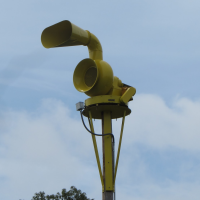 A refurbished BNCO Mobil-Directo Model BN44E, which was located in Memphis, TN. It was replaced by a Sentry 10V2T due to rotator damage caused during installation. | |
| Company | Biersach & Niedermeyer (BNCO) |
|---|---|
| Produced | 1942-1967 |
| Type | Rotational Electromechanical |
| Sound output | 126-130 dB @ 100 ft |
| Frequency | 50/60 Hz |
| Horsepower | 10-25 hp |
| Voltage | 240/550 V AC 3 ph |
| Succeeded by | ACA Allertor 125 |
The Mobil-Directo was a rotational civil defense siren, made by Biersach & Niedermeyer (BNCO) from 1942 until 1967, and was the predecessor of ACA's Allertor 125. It was one of the earliest rotational sirens ever created and boasted unparalleled sound output when it was released. It found extensive use throughout the United States and Canada during the Cold War.
History
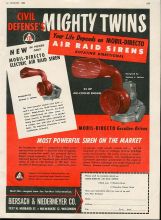
The Mobil-Directo was created in the early 1940s by Biersach & Niedermeyer (BNCO), a steel company that had been in business since 1873, founded by Louis Biersach and August Niedermeyer. The company was contracted by the American government to create a high-powered air raid siren that would be suitable for use in both the domestic market as well as in the Pacific Theatre. The original gas-powered Mobil-Directo would be designed by Sydney J. Lattow—a former salesman for Federal Electric)—and began production in 1942 using the revolutionary principle of a directional, rotational siren. Later in 1948, after the success of the gas-powered variant, an electric variant would begin production. A dual tone chopper would also be introduced. Late in the siren's production, an omnidirectional variant would be sold as the Model 110, though only one is known to have been sold which still survives to this day.
BNCO's siren division became increasingly unprofitable throughout the 1960s as sales waned, and it was thus sold off in 1967, bringing the production of Mobil-Directo sirens to an end after a 25-year production run. BNCO's siren division was bought by James E. Biersach who reformed it into Alerting Communicators of America, partially reusing the design (rotor, stator and projector) for the ACA Allertor 125. Today, Mobil-Directo sirens (the gasoline-powered ones, especially) are very rare, as most have been removed since the end of the Cold War, and/or replaced with newer sirens. Only three electric units still remain in service, 1 converted Model BN52 and 2 Model BN44E units, but the vast majority of remaining units sit silently, rusting away on their poles, a forgotten reminder of the perils of the Cold War. A privately owned BN52 originally from Milwaukee's original system underwent restoration by Jerry Wick and is currently the only operational gasoline-driven unit in existence.
Design
The Mobil-Directo uses a unique split intake/projector design that was later carried over to the Allertor. The bottom horn is the intake, where air is drawn in through the chopper located inside the compression drum, and the sound comes out of the large top horn. The drum serves to compress and pressurize the sound and air, which is then forced out of the top projector horn through an L-bend. The siren's external dual-shafted motor (or engine) drives both the chopper as well as the rotator. The rotator is belt-driven from the motor/engine, using a pair of belts connected to a worm-gear reduction drive that drives a single powered wheel and two unpowered wheels under the siren to rotate the entire siren unit at once on a track. The rotation speed is adjustable from high to low speed plus neutral on gas-driven models. Some Mobil-Directo units used a system of cogs to assist with rotating the siren, though this could cause rotation issues if the cogs became warped or damaged. Something to note on all Mobil-Directo sirens is that the chopper spins the same direction as the rotator does, with both being configured by default to spin clockwise. Due to the bidirectional rotor and stator of the siren, it does not matter which way the siren spins, it will be equally as loud regardless. This applies to both 8 and 10/12-port units.
BN52/BN54
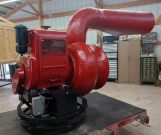
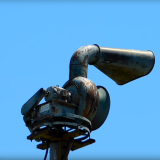
The Model BN52 and Model BN54 are the original gasoline engine-driven models that were first introduced in 1942. The Model BN52 (and later Model BN54) use a 25 hp, VF4 Wisconsin air-cooled V4 flathead gasoline engine to drive the rotor/stator assembly while also rotating the entire siren assembly. This variant was initially produced for the U.S Army for use on remote island airbases in the Pacific Theatre during World War II. In the 1950s, during the height of the Cold War, the Model BN52 and Model BN54 were installed in several cities and towns throughout the United States, especially in California. Approximately 2,000 gasoline powered units were produced and sold until its discontinuation around 1953.
All Model BN52 and Model BN54 units came exclusively in 8-port single tone and were rated at roughly 125-127 dB at 100 ft. Prototype units used 8-port rotors/stators sourced directly from Federal Electric. Production units used a similar rotor cast based on the Federal rotor, but they are not identical. Due to how the engine only supports the rotor on one side, an additional spider bearing is added inside the intake, held up by 3 supports attached to the OD of the stator casting
The rotation gearbox on the siren is configurable, with off, low, and high-speed rotation settings. When the engine is idling, the siren is capable of rotating without sounding off when set to "low" or "high", something an electric unit is incapable of. Because the rotator is driven by the engine, the siren slowly rotates as it idles.
This variant of the siren was designed to be able to operate independently of grid power, which made it particularly useful in areas where electric power was either unreliable, not readily available, or likely to come under attack. The siren could be operated by an operator physically using a switch on the rear of the siren or could alternatively be started and ran remotely using a remote throttle switch. This design concept would be used in several other sirens such as the Thunderbolt 2000 and the Chrysler Air Raid Siren, although this practice fell out of favor by the mid 1950s. The only visible difference between the 2 models are minor engine differences.
One example of a Model BN52 remains in service in Milwaukee, WI, which had been converted to using an electric motor in the 1980s, while another privately owned unit is currently undergoing a full restoration and is operational. Two operational engine-driven units exist, one in San Bernardino, CA (inactive but is apparently operational as of roughly 2015) and the aforementioned privately owned unit, which was restored by Jerry Wick.
BN44E
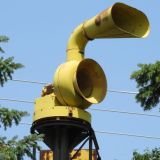
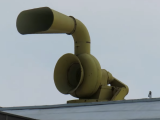
The Model BN44E is the electric motor driven variant of the Mobil-Directo, introduced in 1948. This variant retained most of the same components as the BN52/BN54 but used a dual-sided 10 hp Louis Allis AC electric motor instead of an engine. Canadian units used a different 10 hp motor manufactured by General Supply Co. The BN44E was introduced after it was found that engine-driven sirens were less practical and required much more maintenance than a siren driven by an electric motor.
Both the gasoline-driven BN52/54 and the BN44E were offered alongside each other until the discontinuation of the gasoline-powered variants in 1953, and the electric variant continued to be produced until around 1967, when it was discontinued after BNCO sold off its siren division, which was reformed into ACA.
The BN44E was available in both 8-port single tone as well as 10/12-port dual tone. 10/12-port units were the most common version installed. Some 8-port single tone units are also former Model BN52 and Model BN54 units that were converted. Two examples of a Model BN44E remain in service, an 8-port model in Memphis, TN and a 10/12 model in Pottsville, PA with a replacement projector. The rotor and stator of the 10/12-port BN44E would later be reused for the 10/12-port 1st generation ACA Allertor 125 in 1968, as well as the 10/12-port variants of the ACA Banshee 110 and Screamer S-10.